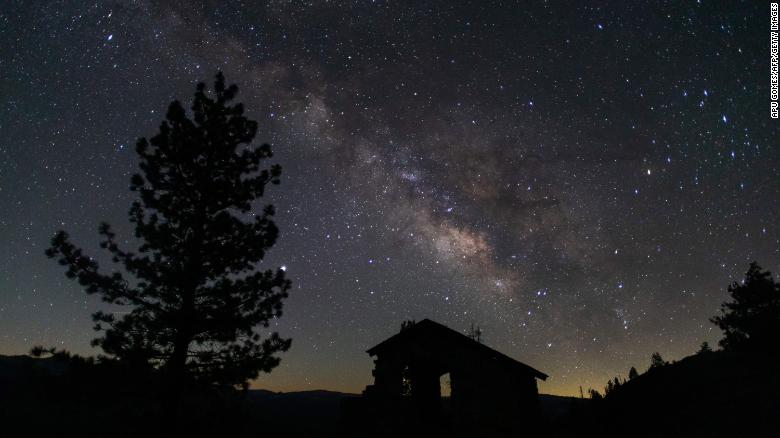(CNN) --
While the lyrid meteor shower in April was obscured by moonlight, astronomers will have another chance to enjoy the eta aquarid meteor shower, which will peak around 12 a.m. ET. on May 5, according to predictions from the American Meteor Society.
However, predictions of its peak vary, and the shower should be visible in the pre-dawn hours of May 4, 5 and 6, according to EarthSky.
The eta aquarid meteor shower, named after the constellation Aquarius, comes from the remnants of Halley's Comet, the famous comet that is visible from Earth every 76 years, according to NASA.
The last time the comet was seen in our skies was in 1986, and we won't see it again until 2061.
While eta aquarids are visible in both the northern and southern hemispheres, they will look even better from the southern hemisphere, where the meteors will be at the top of the night sky, according to NASA.
In the northern hemisphere, the meteors will appear in the lower portion of the sky, as "earthgrazers", that is, they will fly over the Earth's horizon, according to NASA.
Eta Aquarid meteors are known for the speed with which they travel, which can reach 145,000 miles per hour, according to NASA.
Meteors will produce "trains" of light that will remain in the sky for several seconds after their passage.
advertising
The meteor shower will remain active until May 27.
Other meteor showers
The Milky Way as seen from Glacier Point Trailside in Yosemite National Park, California.
Delta Aquarids will be best seen from the southern tropics on July 28-29, when the moon is nearly full.
Interestingly, another meteor shower peaks that same night: the Alpha Capricorns.
While this is a much weaker shower, it is known for producing some bright fireballs during its peak.
This rain will be visible to everyone, regardless of which side of the equator they are on.
The Perseid meteor shower, the most popular of the year, will peak between August 11 and 12 in the northern hemisphere, when the moon is 13% full.
This is the list of meteor showers remaining in 2022, according to EarthSky:
Southern Delta Aquarids: July 29-30
Alpha Capricornids: July 30-31
Perseids: August 11-12
Orionids: October 20-21
Southern Taurids: November 4-5
Northern Taurids: November 11-12
Leonidas: November 17-18
Geminids: December 13-14
Ursids: December 21-22
full moons
There are eight full moon events left to come in 2022, and two of them will be supermoons.
Definitions for supermoon vary, but the term usually refers to a full moon that is brighter and closer to Earth than usual, making it appear larger.
Some astronomers indicate that the phenomenon occurs when the moon is 90% at perigee, which is when the moon's orbit is closest to Earth.
By this definition, the full moons in June and July will be supermoons.
Here is the list of the remaining full moons for 2022, according to The Old Farmer's Almanac:
May 16: flower moon
June 14: strawberry moon
July 13: Stag Moon
August 11: Sturgeon Moon
September 10: Harvest Moon
October 9: Hunter's Moon
November 8: Beaver Moon
December 7: cold moon
Solar and lunar eclipses
In 2022 there will be two total lunar eclipses and two partial solar eclipses, according to The Old Farmer's Almanac.
On October 25, a partial solar eclipse will be visible to people in Greenland, Iceland, Europe, northeast Africa, the Middle East, western Asia, India, and western China.
On April 30, the first of the year took place.
Partial solar eclipses occur when the Moon passes in front of the Sun, but only blocks part of its light.
Make sure you wear proper glasses to view solar eclipses safely, as direct sunlight can be harmful to your eyes.
A total lunar eclipse will be visible to people in Europe, Africa, South America, and North America (except the northwestern regions) between 9:31 p.m. (Miami time) on May 15 and 2:52 a.m. on May 16.
Another total lunar eclipse will also be visible to those in Asia, Australia, the Pacific, South America, and North America on November 8 between 3:01 a.m. ET and 8:58 a.m. ET, but the Moon will set for those in in the eastern regions of North America.
Lunar eclipses can only occur during a full moon, when the Sun, Earth, and Moon align and the Moon passes into Earth's shadow.
The Earth casts two shadows on the Moon during the eclipse.
The penumbra is the partial outer shadow, and the umbra is the full, dark shadow.
When the full moon enters Earth's shadow, it darkens but does not disappear.
Sunlight passing through Earth's atmosphere illuminates the Moon dramatically, turning it red, which is why it is often referred to as a "blood moon."
Depending on the weather conditions in your area, it may be rust, brick, or blood red.
This happens because blue light suffers from greater atmospheric scattering, so red light will be the more dominant color that stands out when sunlight passes through our atmosphere and onto the Moon.
meteor shower










